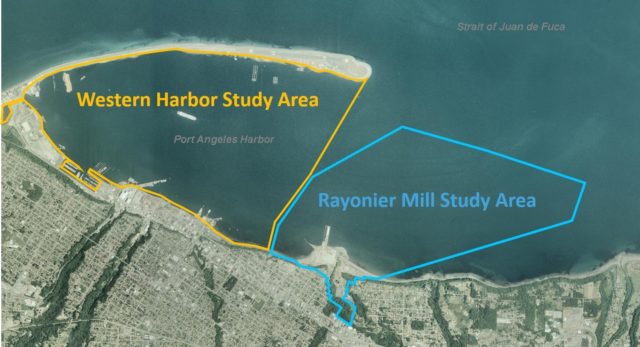
By Pepper Fisher
PORT ANGELES – The Western Harbor contamination cleanup effort in Port Angeles reached a milestone in March with the settling of two consent decrees, allowing the cleanup as well as the restoration projects to go forward.
Both are complicated processes and will take years to complete, but basically, all parties responsible for paying for the cleanup have agreed on who pays how much of the cost, totaling $9.3 million.
One Consent Decree resolves the liability of the Port of Port Angeles, Nippon Paper, Merrill & Ring, Georgia-Pacific, and Owens Corning for $8.5 million. The other Consent Decree resolves the liability of The City of Port Angeles for $800,000. At least in the case of the City of Port Angeles, insurance will cover the cost.
Now it’s the job of the Washington State Department of Ecology to evaluate a completed feasibility study and decide on an action plan for cleaning up the harbor. The person assigned to lead that effort is Rebecca Lawson.
“To get this work done in the harbor is going to be a multi-year process because it’s just the scale is so huge. Cleaning up Port Angeles Harbor, if we look at the Western Harbor, and then we’ve got Rayonier in the eastern part of the harbor, those cleanups will probably be the largest sediment cleanups to have taken place in Washington. But, you know, we’re still a ways off but we’re getting there.”
Lawson says if all goes well, they might have an action plan approved by the end of the year, but the work isn’t expected to begin for a few years yet. She says when it does, you’ll notice.
“There’s going to need to be a large staging area for materials and there will be, you know, truck traffic. I mean all those things are going to be managed and we’ll be reaching out and making sure that the public is well aware ahead of anything like that happening. But I think it’s definitely going to be noticeable to the residents of Port Angeles.”
Completely separate from the cleanup of Western Harbor is the restoration project that will come afterward. That will be handled by the feds at NOAA. To get an idea of what to expect when the time comes, we spoke with NOAA Fisheries Restoration Ecologist Paul Cereghino in Olympia.
He says the restoration cost is based on the estimated damages the pollutants caused to wildlife and humans, including the cultural damages, or lost opportunities to tribes and townspeople.
“The challenge of this kind of thing is, how do you monetize that? How do you turn that into a dollar figure? And the way we do that is by figuring out an equivalent amount of restoration that would make up for the historical damages, and then convert that anticipated amount of restoration into a cash settlement. We’re then going to use that funding to develop and implement restoration projects.”
They’ve drafted a restoration plan, which can be viewed on NOAA’s website, that focuses primarily on the shallow water near the shore, the beach itself, and the offshore habitat where kelp, eel grass, salmon and other wildlife should be thriving.
“And that area, sort of, we call it the bathtub ring of Puget Sound, and it’s where a lot of the action is. In Port Angeles Harbor, that’s a lot of what’s been lost. So we often look for the weak link in the ecosystem and try and figure out how to make that part better. So that’s our general target.”
Cereghino says getting the harbor restored is going to take time and require the cooperation of many players, both public and private, including landowners and the Port of Port Angeles. But he says the biggest hurdle, that of getting everyone involved on the same page, has been cleared.
“Absolutely. I think having a settlement, having a restoration fund in hand that is specifically pointed at Port Angeles Harbor and its resources. It’s sort of an unprecedented opportunity to do work in the harbor in collaboration with all the players that are there.”
